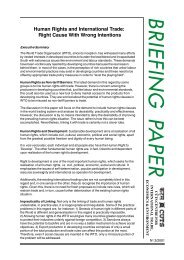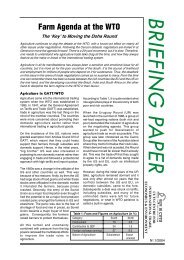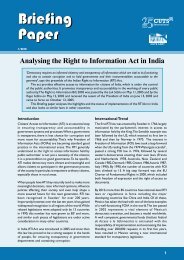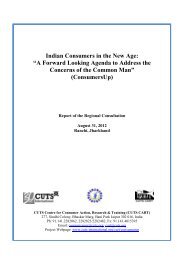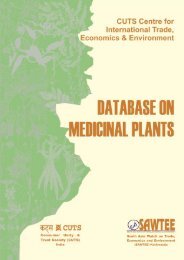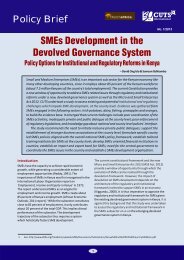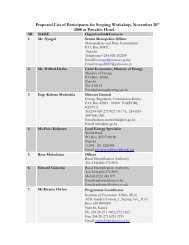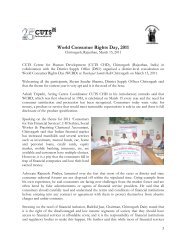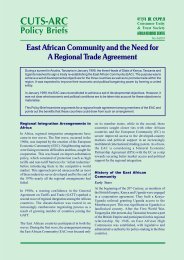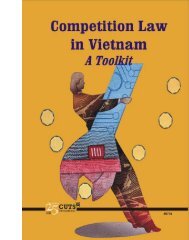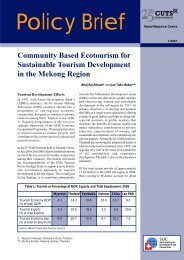Final Report - World Trade Organization
Final Report - World Trade Organization
Final Report - World Trade Organization
Create successful ePaper yourself
Turn your PDF publications into a flip-book with our unique Google optimized e-Paper software.
hand, in its policy on reforms, the Indian law was<br />
diluted in 1991 to exclude merger control, and it<br />
remained in the news mainly on its actions on unfair<br />
trade practices. To that extent, and in spite of the<br />
fact that the Indian Consumer Protection Act, 1986<br />
too covers UTPs, it had developed a popular image<br />
because of its actions on UTPs. However the new<br />
2002 law has excluded UTPs from its coverage and<br />
it has yet to be seen as to how it will gain popularity.<br />
Other laws, such as in Zambia, Tanzania and Sri<br />
Lanka cover UTPs, but the ones in South Africa,<br />
Pakistan, Kenya and now in India, have not covered<br />
UTPs. Many jurisdictions in the world, such as the<br />
USA, Australia and others include UTPs, which help<br />
in image building and thus public acceptance of their<br />
pure competition related cases.<br />
Most of the laws deal with structure rather than<br />
conduct, except in the case of South Africa. India<br />
had ‘structure’ as its main plank in the 1969 law, but<br />
the new 2002 law has shifted entirely to ‘conduct’.<br />
It was stated by the Finance and Company Affairs<br />
Minister in the Parliament: “It is not dominance, but<br />
abuse of dominance, which will form the bedrock of<br />
the new competition law”.<br />
Dealing with conduct is more complex than structure,<br />
as unless the agency has sufficient resources it cannot<br />
build up a good case for prosecution. That will be a<br />
big challenge for the new authority in India, and indeed<br />
all other developing countries.<br />
The first phase of the 7-Up Project was designed to<br />
compare the institutional framework of the project<br />
countries’ competition regimes, as that would enable<br />
a comparison which will be easy and objective.<br />
Further, it could be done within a short time frame.<br />
On the other hand, if one were to compare the<br />
performance of the competition regimes, it would<br />
entail subjective assessment. That would have been<br />
rather difficult and politically problematic. Further, it<br />
would have entailed a longer time frame. Even the<br />
basic survey about the institutional setup took a<br />
substantially longer time period. The survey<br />
questionnaire is annexed at Annexure 4.<br />
Secondly, in both the phases, the project had another<br />
interesting component of a bottom-up approach by<br />
involving a variety of stakeholders including policy<br />
makers and competition authorities. This helped<br />
immensely in raising the profile and the basic issues<br />
of a competition regime and competition culture. The<br />
2 nd phase of the project dealt with cross-border issues<br />
that were dealt with (or not) by the competition<br />
authority, and the awareness about them among an<br />
aware cross section of stakeholders.<br />
As part of the process, a multi-stakeholder national<br />
reference group (NRG) in each country was<br />
established to discuss the issues, the 1 st phase and<br />
the 2 nd phase county reports. This helped to deliberate<br />
on several issues, including subjective ones, which<br />
included the approaches to competition cases. Thus<br />
many dimensions of the competition regime in the<br />
country were discussed, both in isolation and in<br />
comparison with the countries in the project<br />
specifically and other countries outside the project<br />
area.<br />
This chapter covers the inferences drawn from the<br />
research. This includes the discussions at the NRG<br />
and the project review meetings, which were held<br />
over time. A brief report of the NRG meetings and<br />
the review meetings are carried in appendices.<br />
On the basis of the research, the learnings and<br />
recommendations are divided into four parts:<br />
l Operational issues<br />
This part deals with the institutional framework<br />
and implementation issues mainly<br />
l Institution and capacity building<br />
What type of institutional and capacity building is<br />
required<br />
l International cooperation<br />
Speaks about cooperation on capacity building<br />
and handling cross-border issues etc<br />
l Scope and coverage<br />
Best approaches in defining the scope and<br />
coverage of the law<br />
8.1 Operational Issues<br />
Although in several countries the laws themselves<br />
would benefit from some adjustments, the main<br />
problems the 7-Up countries are facing concern their<br />
implementation. In general, the competition agencies<br />
in the project countries are understaffed, lack<br />
resources, etc. See tables 7, 8 and 9 for a brief outline<br />
presented in a matrix format.<br />
1. Inadequate budgets, especially in the South<br />
Asian countries.<br />
Firstly, having the adequate amount of funding is one<br />
of the most crucial factors for any arrangement to<br />
be effective. Indeed the agency can be well funded<br />
but, for example, if it doesn’t have the necessary<br />
86 w Pulling Up Our Socks



